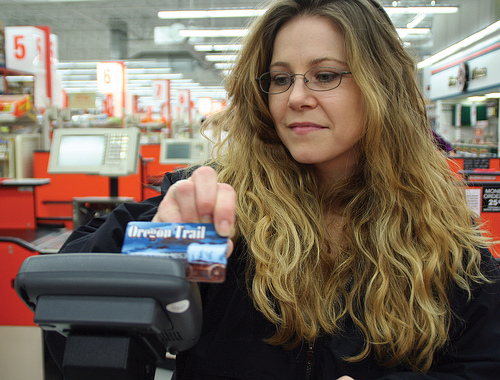
Photo by Brian Duss.
A few months back, we ran a post about the invisibility of modern hunger that looked at the way the current Supplemental Nutrition Assistance Program (SNAP) — with its use of EBT cards that fly under the radar — has made it easy for many to ignore the rampant food insecurity in this country. Meanwhile the use of SNAP benefits, or food stamps as they are often called, has gone through the roof (it rose from $30 billion in 2007 to $72 billion in 2011).
A new report released today called “Food Stamps, Follow the Money” suggests that this invisibility also extends to the mechanisms behind SNAP, and raises questions about just how much food makers, retailers, and big banks may be profiting from food stamps. Not only do big food manufacturers such as Coca-Cola, Kraft, and Mars benefit from the SNAP economy, but retailers (such as Walmart) get a cut of those taxpayer dollars, while banks bring in processing fees. Or, as the report’s author (and occasional Grist contributor) Michele Simon sees it, SNAP “represents the largest, most overlooked corporate subsidy in the farm bill.”
The report also calls for reporting by the USDA on the types of food Americans are buying with food stamps, which are designed (in theory, at least) to make good food more accessible.
“SNAP’s tagline is ‘putting healthy food within reach,'” Simon told Reuters. “Without data on how much money is being spent on Coke versus orange juice, or Lucky Charms versus oatmeal, how will we ever evaluate the nutrition goals of the program?”
Stuffed and Starved author Raj Patel wrote about the report as well, saying:
The USDA goes out of its way to hide the corporate beneficiaries of its program. Through other information, it’s clear that large supermarkets make a great deal of cash out of selling surplus commodities. It’s also clear that banks make bank by charging fees on the electronic transfer of benefits. But no one knows quite how much. And the USDA isn’t telling.
Of course, with Congress — and in particular the GOP-led house — going after food stamps in this year’s farm bill (they’ve proposed cutting $33 billion over the next 10 years), this is a delicate time to look critically at SNAP. But Simon’s report makes it clear that “cutting SNAP benefits at this time of extreme need” would be a bad idea. Nonetheless, she hopes that deconstructing the program — which accounts for around 70 percent of the farm bill — will make more eaters aware of the contradictions involved.
It may seem obvious that a great deal of food stamps are now being redeemed for food that was produced by manufacturing giants like Coca-Cola, Kraft, and Mars in outlets such as Walmart (which sells around one-third of the food in this country), but the other way to see it is that our tax dollars are helping keep these giant businesses giant.
And some of the numbers Simon cites are compelling. For example: “In one year, nine Walmart Supercenters in Massachusetts together received more than $33 million in SNAP dollars — over four times the SNAP money spent at farmers markets nationwide.” Also: “In two years, Walmart received about half of the $1 billion in SNAP expenditures in Oklahoma.”
If there’s any good news to take from the report, it’s that big business is so embedded in SNAP, it’s hard to imagine them letting the House make the kinds of huge cuts I’ve mentioned above. Of course — as is often the case these days — what sounds like good news in the short-term might be very bad news down the road.


